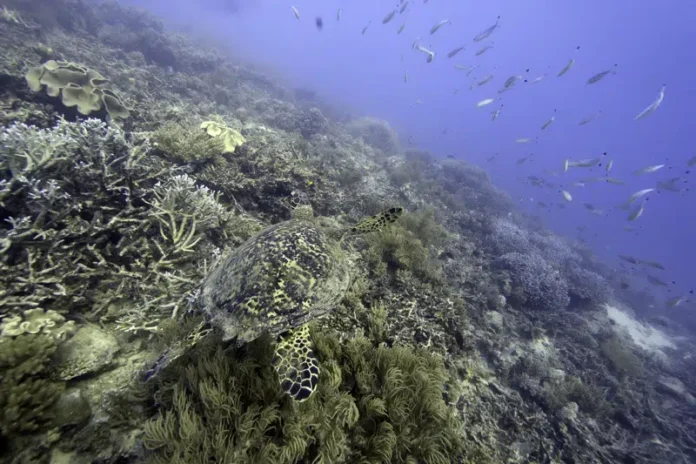WASHINGTON (AP) – For the first time, members of the United Nations have agreed to a unified convention to protect the biodiversity of the high seas.
The United Nations Convention on the Law of the Sea came into force in 1994, before marine biodiversity was a well-established concept. The contract agreement ended his two-week consultation in New York.
A modern framework for protecting marine life in the transboundary waters known as the high seas has been under discussion for more than two decades, but previous efforts to reach agreement have repeatedly stalled. A unity pact covering nearly half of the world’s surface was reached late Saturday. “We have only two major global commons, the atmosphere and the oceans,” says Rebecca Helm, a marine biologist in Georgetown. Protecting this half of the world is absolutely critical to the health of our planet.”
Nicola Clarke, a marine expert at the Pew Charitable Trust, observed the meeting in New York and called the long-awaited treaty text “a unique opportunity to protect the oceans – a big win for biodiversity.”
The treaty creates a new body to manage the protection of marine life and establish marine protected areas on the high seas. Mr Clark said this was important in order to meet the United Nations Biodiversity Conference’s recent pledge to protect his 30% of the earth’s water bodies and to protect his country.
Contract negotiations were originally scheduled to end on Friday, but were extended overnight until Saturday. The drafting of the sometimes endangered agreement is a “historic and overwhelming success for international ocean protection,” said Federal Environment Minister Steffi Lemke. “For the first time, we have a binding agreement on the high seas, which has been largely unprotected,” Lemke said. “More than 40% of the Earth’s surface is finally under comprehensive protection for endangered species and habitats.”
The agreement also establishes ground rules for conducting environmental impact assessments of commercial activities at sea.
“This means that not all planned activities on the high seas will be fully evaluated, but must be reviewed,” said Jessica Battle, an ocean policy expert at the World Wildlife Fund.
Several marine species, including dolphins, whales, sea turtles and many fish, make long migrations each year across national borders and high seas. Human communities that depend on fishing and marine-related tourism, along with efforts to protect them, have long proven difficult for international governing bodies. “This treaty will help bring together different regional treaties to address threats and concerns across the range of species,” Battle said.
Its protection will also benefit coastal biodiversity and economies, said Gladys Martinez de Lemos, executive director of the nonprofit American Environmental Defense Association, which focuses on environmental issues across Latin America.
“Governments have taken important steps to strengthen the legal protection of her two-thirds of the ocean, thus enhancing marine biodiversity and the livelihoods of coastal communities,” she said.
The question is how well the ambitious deal will be executed.
Official approval has yet to come, and many conservationists and environmental groups have pledged to keep a close eye on the plan. The high seas have long been plagued by exploitation from commercial fishing and mining, and pollution from chemicals and plastics. Malin Pinsky, a biologist at Rutgers University, said the new agreement “recognises that the ocean is not an infinite resource and that sustainable use of the ocean requires global cooperation.
Saturday, December 6, 2025
More
© London Post, All Rights Reserved by Independent Media Group UK Limited.





![Los Angeles races to contain wildfires before severe winds return Firefighters raced to contain the frontiers of two Los Angeles wildfires that burned for the sixth straight day on Sunday, taking advantage of a brief respite in hazardous conditions before high winds were expected to fan the flames anew. At least 24 people have died in what California Governor Gavin Newsom said could be the most devastating natural disaster in U.S. history, one that has destroyed thousands of homes and forced 100,000 people to evacuate. Advertisement · Scroll to continue Flames have reduced whole neighborhoods to smoldering ruins, leveling the homes of the rich and famous and ordinary folk alike, and leaving an apocalyptic landscape. Officials said at least 12,300 structures have been damaged or destroyed. "L.A. County had another night of unimaginable terror and heartbreak," Los Angeles County Supervisor Lindsey Horvath said. Aerial firefighters, some of them scooping water out of the Pacific Ocean, dropped water and retardant while land crews with hand tools and hoses held the line of the Palisades Fire as it encroached on the upscale Brentwood section and other populated areas of Los Angeles. Advertisement · Scroll to continue That fire on the western side of town has consumed 23,713 acres (96 sq km) or 37 square miles and stood at 13% contained, a figure representing the percentage of the fire's perimeter that firefighters have under control. The Eaton Fire in the foothills east of Los Angeles scorched another 14,117 acres (57 sq km) or 22 square miles - itself nearly the size of Manhattan - and firefighters increased the containment to 27%, up from 15% a day earlier. North of the city, the Hurst Fire was 89% contained, and three other fires that had ravaged other parts of the county were now 100% contained, the California Department of Forestry and Fire Protection (Cal Fire) reported, though areas within the containment lines may still be burning. SEVERE WINDS RETURN Firefighters got a temporary break from the weather this weekend as Santa Ana winds, which reached hurricane force earlier in the week, finally eased. The dry winds originating from the inland deserts had fanned flames and blew embers up to 2 miles (3 km) ahead of the front lines. But, in an area that has not received any rain of note since April, the National Weather Service forecast Santa Ana winds of up to 50 to 70 miles per hour (80 to 112 kph) would resume on Sunday night (U.S. West Coast time) and last through Wednesday. Officials warned the entire Los Angeles County population of nearly 10 million that anyone may be ordered to evacuate from the flames and toxic smoke. By Sunday, more than 100,000 people in Los Angeles County had been ordered to evacuate - down from a previous high of more than 150,000 - while another 87,000 faced evacuation warnings. "These winds combined with low relative humidities and low fuel moistures will keep the fire threat in all of Los Angeles County very high," Los Angeles County Fire Chief Anthony Marrone told a press conference, adding that evacuated areas may not be reopened until red flag conditions are lifted on Thursday. Even so, schools except some in mandatory evacuation zones would reopen on Monday, after closing for all 429,000 students in the Los Angeles Unified School District on Thursday and Friday, Superintendent Alberto Carvalho announced. Item 1 of 18 Firefighters work to clear a firebreak as the Palisades Fire, one of several simultaneous blazes that have ripped across Los Angeles County, burns in Mandeville Canyon, a neighborhood of Los Angeles, California, U.S., January 12, 2025. REUTERS/Ringo Chiu [1/18]Firefighters work to clear a firebreak as the Palisades Fire, one of several simultaneous blazes that have ripped across Los Angeles County, burns in Mandeville Canyon, a neighborhood of Los Angeles, California, U.S., January 12, 2025. REUTERS/Ringo Chiu Purchase Licensing Rights, opens new tab Newsom told NBC News the fires were likely to be the worst natural disaster in U.S. history "in terms of just the costs associated with it." The Los Angeles County Medical Examiner reported 24 deaths from the fires. Private forecaster AccuWeather has estimated the damage and economic loss at $135 billion to $150 billion. To help expedite the monumental rebuilding effort ahead, Newsom signed an executive order on Sunday temporarily suspending environmental regulations for destroyed homes and businesses. Active duty military personnel are ready to support the firefighting effort, FEMA Administrator Deanne Criswell said in a series of Sunday television interviews, adding the agency has urged residents to begin filing for disaster relief. Firefighters from seven states, Canada and Mexico have already converged on the Los Angeles area to help fire departments from around the state. HIGH ANXIETY Hundreds of people displaced by the fires attended mass at the St. Monica Catholic Church in Santa Monica on Sunday, including parishioners whose churches were destroyed. Kathleen McRoskey, who attended mass regularly at Pacific Palisades' ruined Corpus Christi church for over 40 years, said she was grateful to St. Monica for opening its doors to those who lost their homes and place of worship. "It was the first offer of support that would heal us spiritually and physically and emotionally," she said. In Altadena on the edge of the Eaton Fire, Tristin Perez said he never left his home, defying police orders to evacuate as the fire raced down the hillside. Instead, Perez insisted on trying to save his property and his neighbors' homes. "Your front yard is on fire, palm trees lit up – it looked like something out of a movie," Perez told Reuters in an interview in his driveway. "I did everything I could to stop the line and save my house, help save their houses." His one-story yellow duplex survived. So did two more homes next door. Across the street, entire houses burned to the ground. "A lot of these areas still look like they were hit by a bomb. There are live electrical wires, gas lines and other hazards," said Los Angeles County Sheriff Robert Luna. Zuzana Korda was evacuated from her home in the Fernwood neighborhood in Topanga, northwest of Los Angeles. Speaking outside a temporary assistance office at the West Hollywood Public Library, she said her landlord told her the family home was still standing, but she was anxious. "We've left everything behind. We have no insurance," Korda said. "We stand to lose everything."](https://londonpost.news/wp-content/uploads/2025/01/download-29-218x150.jpeg)
